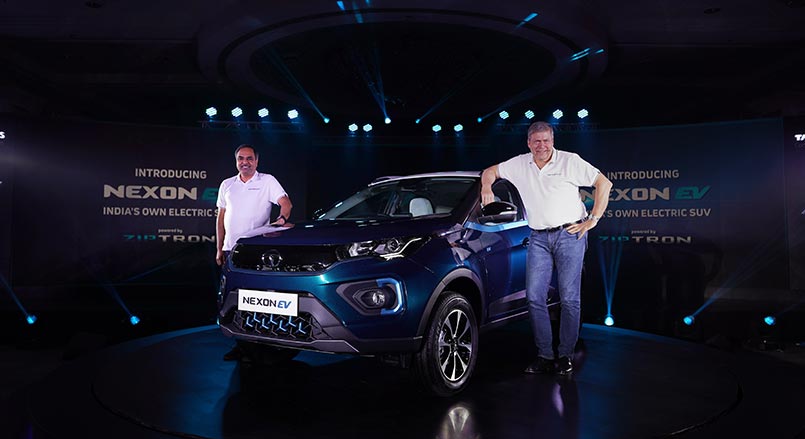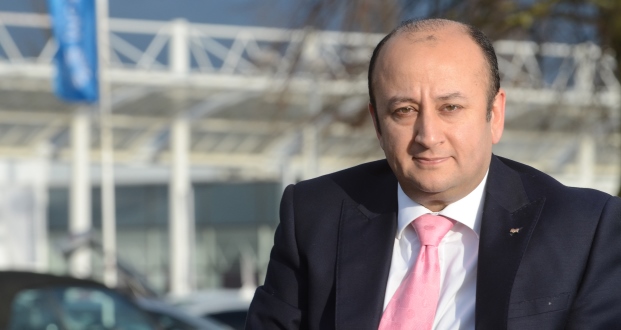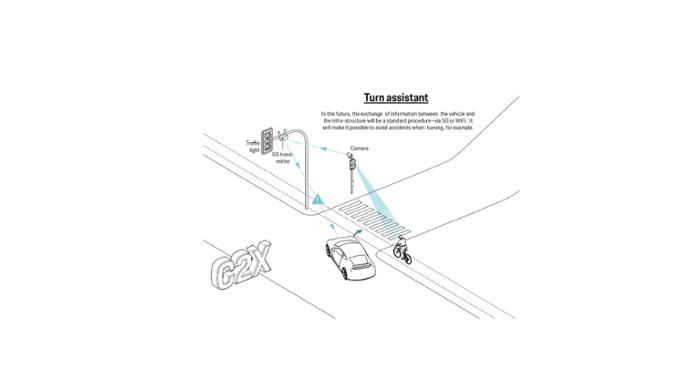19 December, 2019 Offers a cool, stylish, practical and real-world solution for faster EV adoption in India Mr. Guenter Butschek, CEO & Managing Director, Tata Motors Ltd. and Mr. Shailesh Chandra, President – Electric Mobility Business & Corporate Strategy, Tata Motors Ltd. unveil India’s own Electric SUV, the Nexon EV, today. Powered by the cutting-edge… Continue reading @Tata: Nexon EV unveiling
Tag: VW
VW Brand CFO Urges Efficiency Boost at German Factories
Volkswagen AG’s namesake passenger-car brand is sticking to its financial goals, though the company acknowledged the need to improve productivity in high-cost Germany to remain competitive.
Volkswagen attracts bids for MAN Energy Solutions unit -sources
FRANKFURT (Reuters) – Volkswagen (VOWG_p.DE) has attracted bids from Europe’s Innio, Japan’s Mitsubishi Heavy (7011.T) and U.S.-based Cummins (CMI.N) for its MAN Energy Solutions, which makes diesel engines for ships and power generators, people close to the matter said. The logo of Volkswagen is pictured at the LA Auto Show in Los Angeles, California, U.S.,… Continue reading Volkswagen attracts bids for MAN Energy Solutions unit -sources
Volkswagen brand to post record profit on SUVs, cost cuts: executive
FILE PHOTO: Volkswagen sign is seen during the annual earnings news conference of VW in Berlin in Berlin, Germany, March 13, 2018. REUTERS/Hannibal Hanschke WOLFSBURG, Germany (Reuters) – Volkswagen’s (VOWG_p.DE) namesake core brand is on track to post a record operating profit this year thanks to cost savings and its increased sales of sports utility… Continue reading Volkswagen brand to post record profit on SUVs, cost cuts: executive
Skoda Auto India unveils a part sketch of India-specific SUV
PUNE: Skoda Auto India on Wednesday unveiled the first sketch of the interiors of the yet-to-be-launched compact SUV designed for the Indian market. The company will be developing the compact SUV, Skoda Vision In, on the MQB platform. MQB stands for Modularer Querbaukasten. It lays down a series of hard points for a huge range… Continue reading Skoda Auto India unveils a part sketch of India-specific SUV
Marshall buys Volkswagen and Skoda dealerships from Jardine
Marshall Motor Holdings has bought Volkswagen and Skoda car and CV businesses from Jardine Motor Group for £9.3m. The deal, for £22.3m cash with £13m of inventory, includes six Volkswagen car franchises in Aylesbury, Harlow, Letchworth, Loughton, Milton Keynes and St Albans, a Volkswagen commercial vehicle franchise and bodyshop in Loughton and a Skoda passenger… Continue reading Marshall buys Volkswagen and Skoda dealerships from Jardine
Mercedes EQC Deliveries Delayed Until 2021
Invest
Electric Cars
Electric Car Benefits
Electric Car Sales
Solar Energy Rocks
RSS
Advertise
Privacy Policy
Cars
Published on December 15th, 2019 |
by Johnna Crider
Mercedes EQC Deliveries Delayed Until 2021
Twitter
LinkedIn
Facebook
December 15th, 2019 by Johnna Crider
Mercedes has announced they it will delay the US launch of its first electric vehicle, the EQC, which starts at $68,895. Those who call Tesla a “vaporware” company should take note. Mercedes was expected to bring the EQC to its US dealerships in the first quarter of 2020, but it looks like we will have to wait another whole year for one of those “Tesla killers.” The reason for the wait? Mercedes says demand is too high in Europe for the company to bring it to the US.
Demand may be high in Europe for the Mercedes EQC, but as Maarten Vinkhuyzen has explained for us before, automakers have a much easier time selling EVs in Europe due to both its stronger vehicle emission regulations (forcing automakers to start selling EVs in higher quantities or face fines) and a better dealership system (customers are accustomed to ordering their cars in advance rather than going onto a dealership lot and choosing from the options on hand). The need to increase a good flow of EV sales in Europe is only growing, too. The EU Parliament is now mandating a 37.5% cut in new vehicle emissions by 2030.
Naturally, people who are reservation holders of the EQC may cancel and decide to purchase a Tesla for either a similar or even a lower price. They may conclude that while they previously thought it was wiser and “safer” to go with a conventional automaker, Tesla is in fact leading the industry for a reason.
This delay means that Mercedes, which is owned by Daimler, may suffer some financial consequences as Tesla and other EV makers — such as Audi, BMW, and Jaguar — pass it up on the road to meeting US EV demands. Daimler just announced plans last month to cut thousands of jobs. Perhaps being late to the electric party was not a good idea.
The EQC was once termed a “Tesla killer,” which means an EV that would ultimately destroy Tesla. I used to think that term was very negative, but I’ve had second thoughts. It’s inspiring in a sense — it’s about this urge or need to destroy a competitor by making something better. It inherently compels automakers to make better EVs.
The irony is that, if a “Tesla killer” was to exist, it would be fulfilling Tesla’s mission. I don’t think that will happen for a very long time since Tesla is the star of the 21st century automotive industry and everyone else seems far behind. But it would be good if other automakers genuinely tried to make Tesla killers.
Follow CleanTechnica on Google News.
It will make you happy & help you live in peace for the rest of your life.
About the Author
Johnna Crider Johnna Crider is a Baton Rouge artist, gem and mineral collector, and Tesla shareholder who believes in Elon Musk and Tesla. Elon Musk advised her in 2018 to “Believe in Good.”
Tesla is one of many good things to believe in. You can find Johnna on Twitter
Back to Top ↑
Advertisement
Advertise with CleanTechnica to get your company in front of millions of monthly readers.
Top News On CleanTechnica
Cleantech Press Releases
ABB Analyzes The Habits Of Bees To Develop New Computer Vision Tech
Hannon Armstrong & Summit Ridge To Jointly Invest In Community Solar; Initial Projects Launching in Maryland
“That Was Quick” Category: Carbon Engineering Partners With Occidental To Pump More Oil
Our New Electric Car Driver Report
Read our new report on electric car drivers, what they desire, and what they require.
CleanTechnica Clothing & Cups
Listen to CleanTech TalkJoin CleanTechnica Today!
30 Electric Car Benefits
Our Electric Vehicle Reviews
EV Charging Guidelines for Cities
Read & share our free report on “EV charging guidelines for cities.”
Tesla News
Advertisement
Advertisement
Follow CleanTechnica Follow @cleantechnica
© 2019 Sustainable Enterprises Media, Inc.
Invest
Electric Cars
Electric Car Benefits
Electric Car Sales
Solar Energy Rocks
RSS
Advertise
Privacy Policy
This site uses cookies: Find out more.Okay, thanks
@VW Group: Car.Software organization strengthens Board of Management
The Volkswagen Group’s Car.Software organization is strengthening its Board of Management. With effect from January 1, 2020, Björn Goerke is to be the Chief Technology Officer (CTO) of the Car.Software organization. To date, Goerke has been Chief Technology Officer and President SAP Cloud Platform with the software company SAP. In his new function, he is… Continue reading @VW Group: Car.Software organization strengthens Board of Management
@VW Group: Concept study ŠKODA VISION IN: Interior sketch gives first glimpse of new compact SUV for the Indian market
The sketch shows a wide dashboard arranged on several levels, which echoes the symmetrical contours of the ŠKODA grille in the centre. The colour orange, which inspires vitality and creativity, is used extensively throughout the interior, for example, on the centre armrest and door panels. The chrome-plated ventilation nozzles on the side are also eye-catching,… Continue reading @VW Group: Concept study ŠKODA VISION IN: Interior sketch gives first glimpse of new compact SUV for the Indian market
@VW Group: Fast network for smart cars
The data volumes being transmitted via wireless networks are rising inexorably, due primarily to increasing machine-to-machine communication (M2M communication). In the automotive field, it is primarily fully automated driving that is spurring on this development: While the data volumes per hour in current highly networked vehicles are in the gigabyte range today, by 2025 the… Continue reading @VW Group: Fast network for smart cars



